Analysis of a Carpooling System in Dublin: A Simulation
VerifiedAdded on 2022/09/27
|30
|7878
|36
Project
AI Summary
This project investigates the potential of carpooling as a solution to reduce travel time and congestion in Dublin. The research utilizes a simulation model built on the Janus multi-agent platform to analyze the effects of carpooling. The study begins with an introduction to the concept of carpooling, its benefits, and the current transportation challenges in Dublin. It then explores the existing public transport systems, including buses, commuter rail, DART, Luas, and Dublin Bikes, highlighting their limitations. The core of the project involves the development of a carpooling model, including the creation of agents representing car users and the implementation of matching algorithms. The model simulates scenarios where agents traveling in the same direction share a car, and the results are used to compare the time and cost of carpooling with other modes of transport. The findings aim to determine if carpooling can provide a viable alternative to reduce travel time and improve the efficiency of the transportation network in Dublin, addressing issues of congestion and environmental impact.
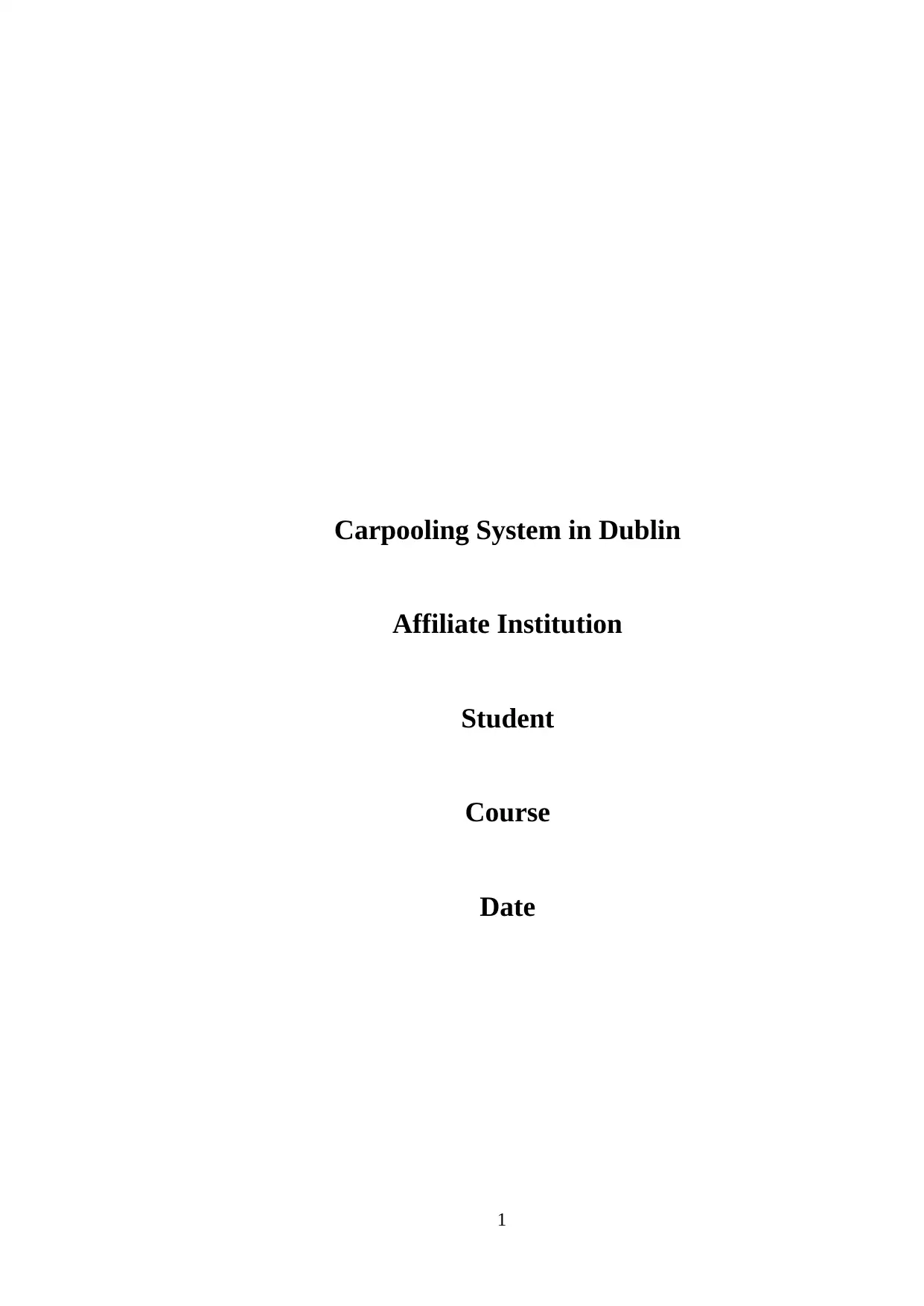
1
Carpooling System in Dublin
Affiliate Institution
Student
Course
Date
Carpooling System in Dublin
Affiliate Institution
Student
Course
Date
Paraphrase This Document
Need a fresh take? Get an instant paraphrase of this document with our AI Paraphraser
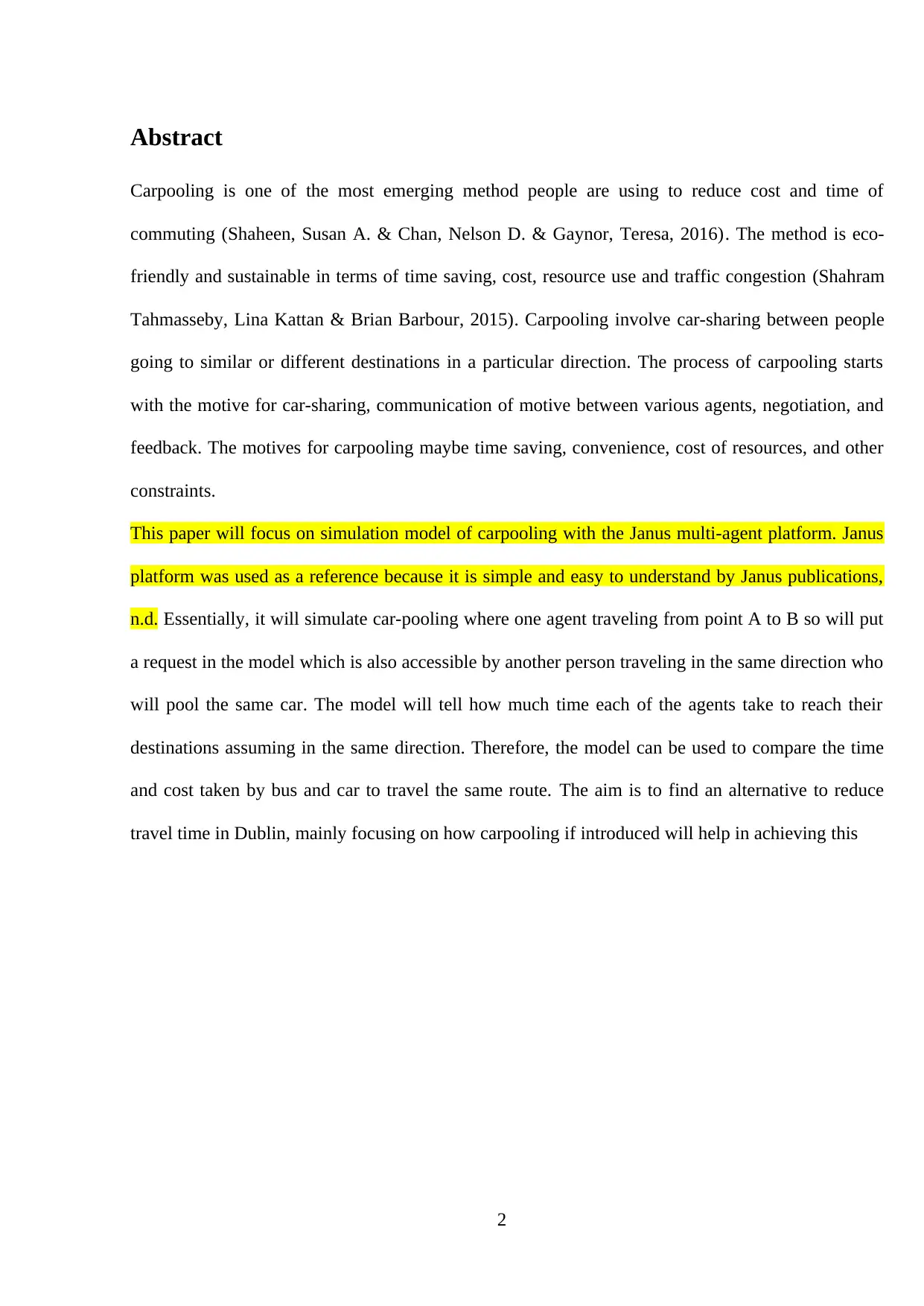
2
Abstract
Carpooling is one of the most emerging method people are using to reduce cost and time of
commuting (Shaheen, Susan A. & Chan, Nelson D. & Gaynor, Teresa, 2016). The method is eco-
friendly and sustainable in terms of time saving, cost, resource use and traffic congestion (Shahram
Tahmasseby, Lina Kattan & Brian Barbour, 2015). Carpooling involve car-sharing between people
going to similar or different destinations in a particular direction. The process of carpooling starts
with the motive for car-sharing, communication of motive between various agents, negotiation, and
feedback. The motives for carpooling maybe time saving, convenience, cost of resources, and other
constraints.
This paper will focus on simulation model of carpooling with the Janus multi-agent platform. Janus
platform was used as a reference because it is simple and easy to understand by Janus publications,
n.d. Essentially, it will simulate car-pooling where one agent traveling from point A to B so will put
a request in the model which is also accessible by another person traveling in the same direction who
will pool the same car. The model will tell how much time each of the agents take to reach their
destinations assuming in the same direction. Therefore, the model can be used to compare the time
and cost taken by bus and car to travel the same route. The aim is to find an alternative to reduce
travel time in Dublin, mainly focusing on how carpooling if introduced will help in achieving this
Abstract
Carpooling is one of the most emerging method people are using to reduce cost and time of
commuting (Shaheen, Susan A. & Chan, Nelson D. & Gaynor, Teresa, 2016). The method is eco-
friendly and sustainable in terms of time saving, cost, resource use and traffic congestion (Shahram
Tahmasseby, Lina Kattan & Brian Barbour, 2015). Carpooling involve car-sharing between people
going to similar or different destinations in a particular direction. The process of carpooling starts
with the motive for car-sharing, communication of motive between various agents, negotiation, and
feedback. The motives for carpooling maybe time saving, convenience, cost of resources, and other
constraints.
This paper will focus on simulation model of carpooling with the Janus multi-agent platform. Janus
platform was used as a reference because it is simple and easy to understand by Janus publications,
n.d. Essentially, it will simulate car-pooling where one agent traveling from point A to B so will put
a request in the model which is also accessible by another person traveling in the same direction who
will pool the same car. The model will tell how much time each of the agents take to reach their
destinations assuming in the same direction. Therefore, the model can be used to compare the time
and cost taken by bus and car to travel the same route. The aim is to find an alternative to reduce
travel time in Dublin, mainly focusing on how carpooling if introduced will help in achieving this
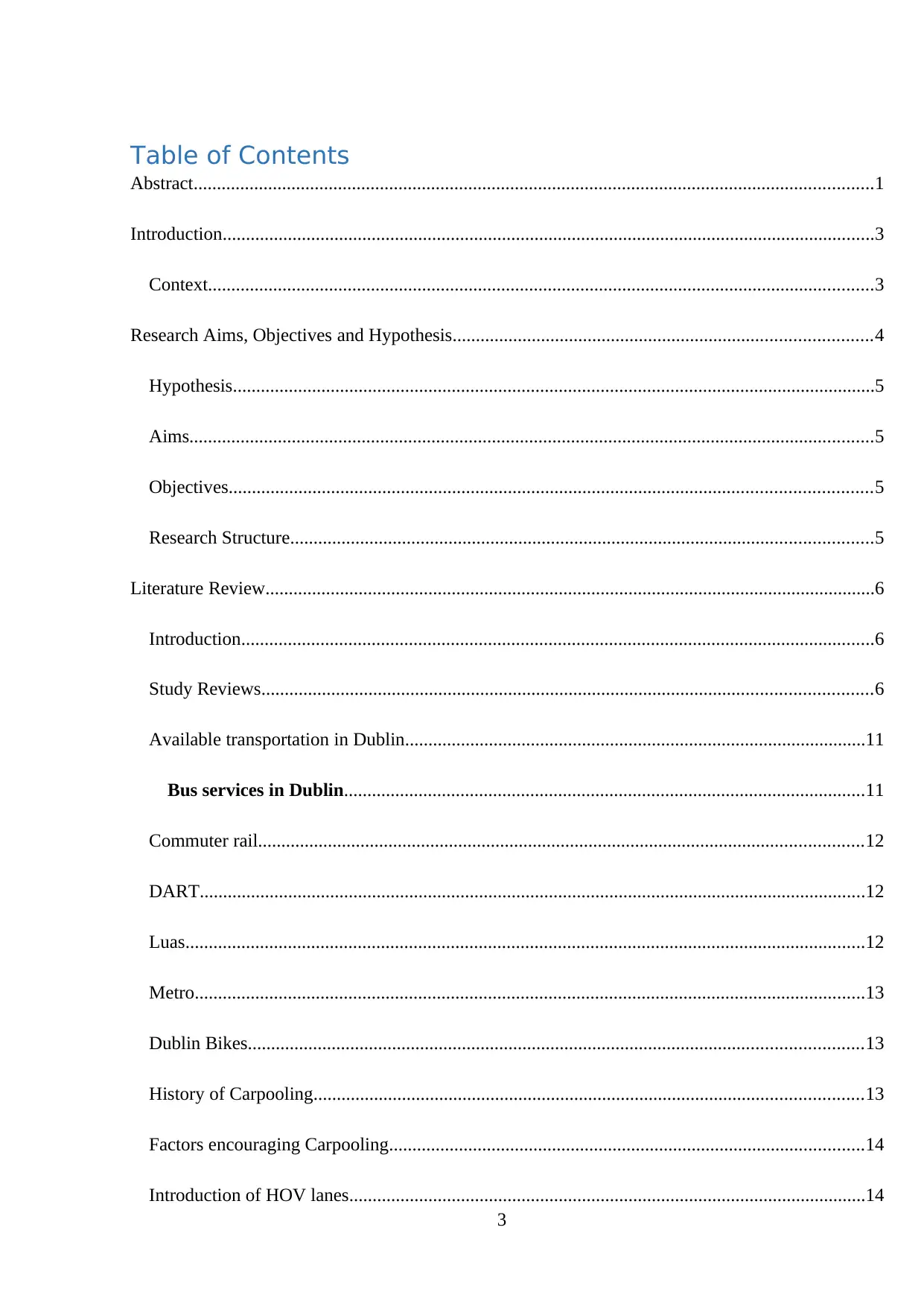
3
Table of Contents
Abstract..................................................................................................................................................1
Introduction............................................................................................................................................3
Context...............................................................................................................................................3
Research Aims, Objectives and Hypothesis..........................................................................................4
Hypothesis..........................................................................................................................................5
Aims...................................................................................................................................................5
Objectives..........................................................................................................................................5
Research Structure.............................................................................................................................5
Literature Review...................................................................................................................................6
Introduction........................................................................................................................................6
Study Reviews...................................................................................................................................6
Available transportation in Dublin...................................................................................................11
Bus services in Dublin................................................................................................................11
Commuter rail..................................................................................................................................12
DART...............................................................................................................................................12
Luas..................................................................................................................................................12
Metro................................................................................................................................................13
Dublin Bikes....................................................................................................................................13
History of Carpooling......................................................................................................................13
Factors encouraging Carpooling......................................................................................................14
Introduction of HOV lanes...............................................................................................................14
Table of Contents
Abstract..................................................................................................................................................1
Introduction............................................................................................................................................3
Context...............................................................................................................................................3
Research Aims, Objectives and Hypothesis..........................................................................................4
Hypothesis..........................................................................................................................................5
Aims...................................................................................................................................................5
Objectives..........................................................................................................................................5
Research Structure.............................................................................................................................5
Literature Review...................................................................................................................................6
Introduction........................................................................................................................................6
Study Reviews...................................................................................................................................6
Available transportation in Dublin...................................................................................................11
Bus services in Dublin................................................................................................................11
Commuter rail..................................................................................................................................12
DART...............................................................................................................................................12
Luas..................................................................................................................................................12
Metro................................................................................................................................................13
Dublin Bikes....................................................................................................................................13
History of Carpooling......................................................................................................................13
Factors encouraging Carpooling......................................................................................................14
Introduction of HOV lanes...............................................................................................................14
⊘ This is a preview!⊘
Do you want full access?
Subscribe today to unlock all pages.

Trusted by 1+ million students worldwide
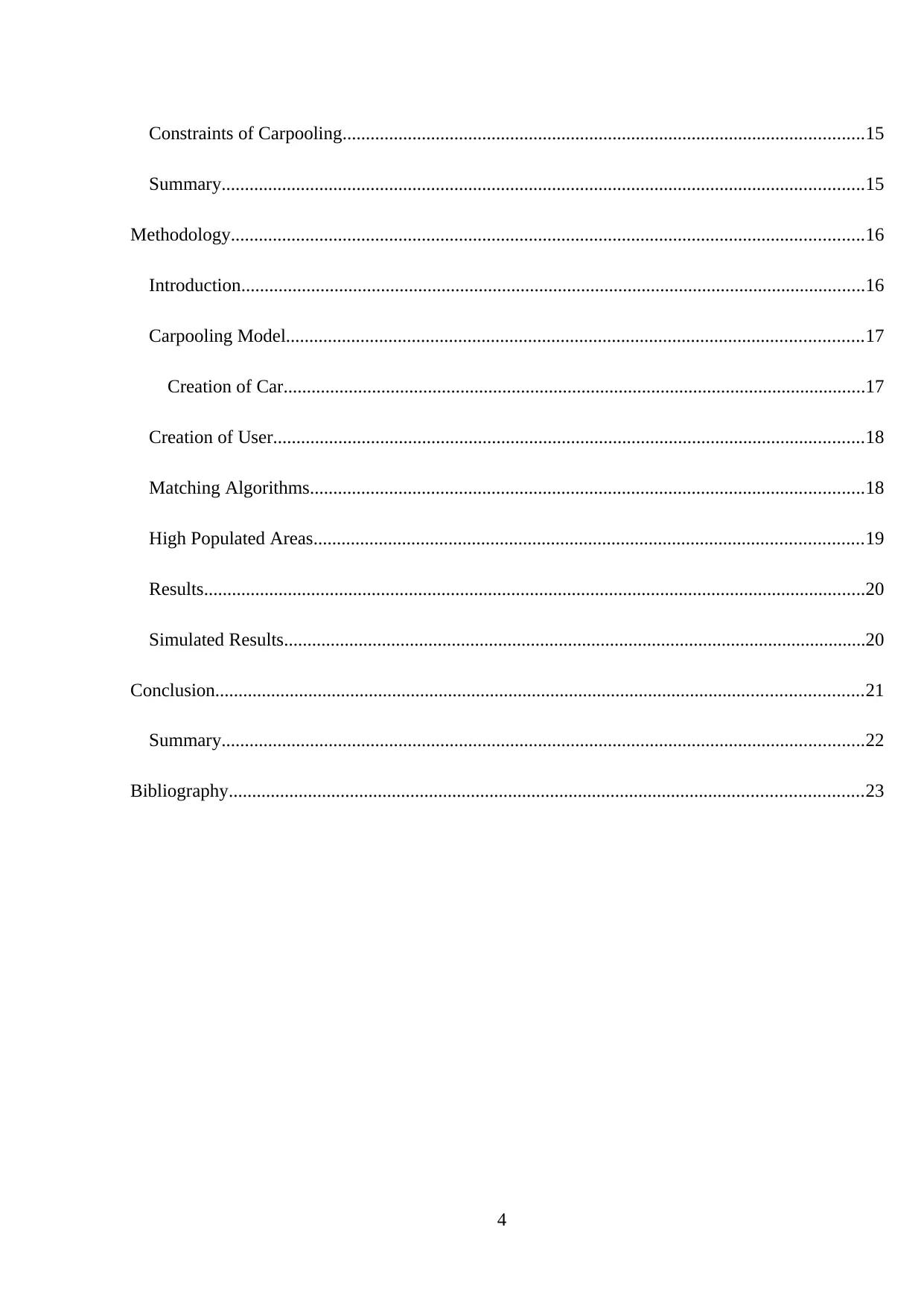
4
Constraints of Carpooling................................................................................................................15
Summary..........................................................................................................................................15
Methodology........................................................................................................................................16
Introduction......................................................................................................................................16
Carpooling Model............................................................................................................................17
Creation of Car.............................................................................................................................17
Creation of User...............................................................................................................................18
Matching Algorithms.......................................................................................................................18
High Populated Areas......................................................................................................................19
Results..............................................................................................................................................20
Simulated Results.............................................................................................................................20
Conclusion...........................................................................................................................................21
Summary..........................................................................................................................................22
Bibliography........................................................................................................................................23
Constraints of Carpooling................................................................................................................15
Summary..........................................................................................................................................15
Methodology........................................................................................................................................16
Introduction......................................................................................................................................16
Carpooling Model............................................................................................................................17
Creation of Car.............................................................................................................................17
Creation of User...............................................................................................................................18
Matching Algorithms.......................................................................................................................18
High Populated Areas......................................................................................................................19
Results..............................................................................................................................................20
Simulated Results.............................................................................................................................20
Conclusion...........................................................................................................................................21
Summary..........................................................................................................................................22
Bibliography........................................................................................................................................23
Paraphrase This Document
Need a fresh take? Get an instant paraphrase of this document with our AI Paraphraser
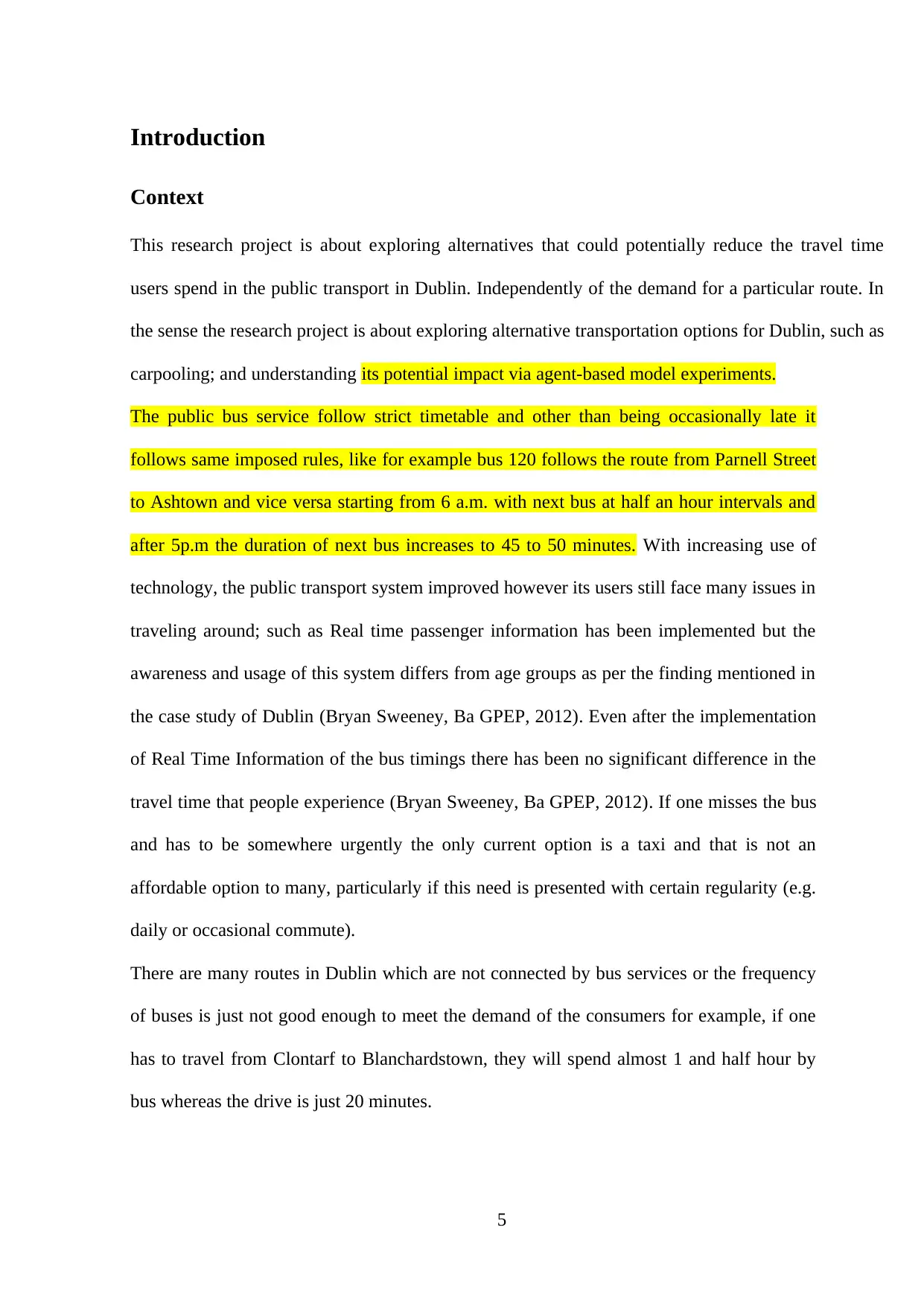
5
Introduction
Context
This research project is about exploring alternatives that could potentially reduce the travel time
users spend in the public transport in Dublin. Independently of the demand for a particular route. In
the sense the research project is about exploring alternative transportation options for Dublin, such as
carpooling; and understanding its potential impact via agent-based model experiments.
The public bus service follow strict timetable and other than being occasionally late it
follows same imposed rules, like for example bus 120 follows the route from Parnell Street
to Ashtown and vice versa starting from 6 a.m. with next bus at half an hour intervals and
after 5p.m the duration of next bus increases to 45 to 50 minutes. With increasing use of
technology, the public transport system improved however its users still face many issues in
traveling around; such as Real time passenger information has been implemented but the
awareness and usage of this system differs from age groups as per the finding mentioned in
the case study of Dublin (Bryan Sweeney, Ba GPEP, 2012). Even after the implementation
of Real Time Information of the bus timings there has been no significant difference in the
travel time that people experience (Bryan Sweeney, Ba GPEP, 2012). If one misses the bus
and has to be somewhere urgently the only current option is a taxi and that is not an
affordable option to many, particularly if this need is presented with certain regularity (e.g.
daily or occasional commute).
There are many routes in Dublin which are not connected by bus services or the frequency
of buses is just not good enough to meet the demand of the consumers for example, if one
has to travel from Clontarf to Blanchardstown, they will spend almost 1 and half hour by
bus whereas the drive is just 20 minutes.
Introduction
Context
This research project is about exploring alternatives that could potentially reduce the travel time
users spend in the public transport in Dublin. Independently of the demand for a particular route. In
the sense the research project is about exploring alternative transportation options for Dublin, such as
carpooling; and understanding its potential impact via agent-based model experiments.
The public bus service follow strict timetable and other than being occasionally late it
follows same imposed rules, like for example bus 120 follows the route from Parnell Street
to Ashtown and vice versa starting from 6 a.m. with next bus at half an hour intervals and
after 5p.m the duration of next bus increases to 45 to 50 minutes. With increasing use of
technology, the public transport system improved however its users still face many issues in
traveling around; such as Real time passenger information has been implemented but the
awareness and usage of this system differs from age groups as per the finding mentioned in
the case study of Dublin (Bryan Sweeney, Ba GPEP, 2012). Even after the implementation
of Real Time Information of the bus timings there has been no significant difference in the
travel time that people experience (Bryan Sweeney, Ba GPEP, 2012). If one misses the bus
and has to be somewhere urgently the only current option is a taxi and that is not an
affordable option to many, particularly if this need is presented with certain regularity (e.g.
daily or occasional commute).
There are many routes in Dublin which are not connected by bus services or the frequency
of buses is just not good enough to meet the demand of the consumers for example, if one
has to travel from Clontarf to Blanchardstown, they will spend almost 1 and half hour by
bus whereas the drive is just 20 minutes.
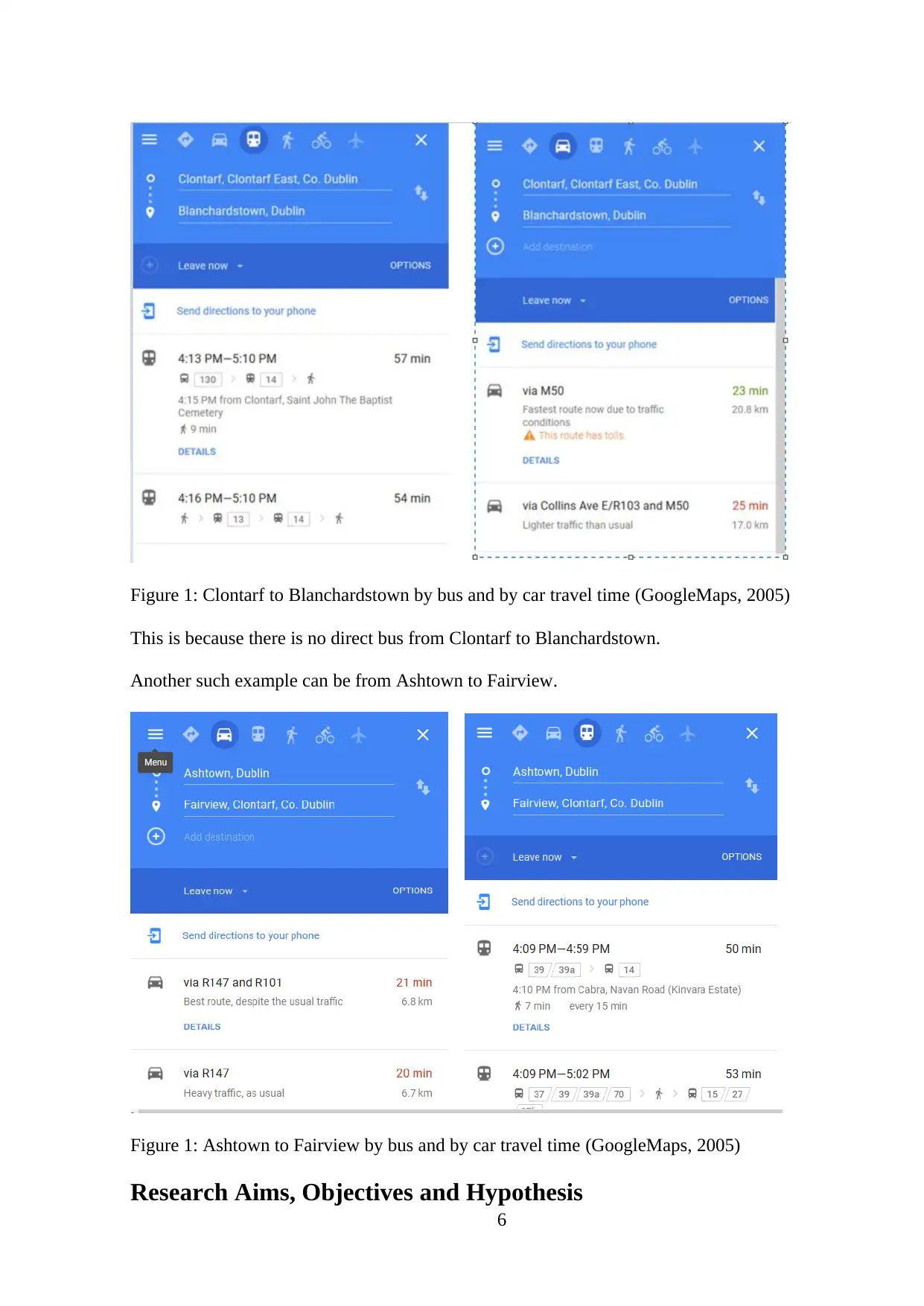
6
Figure 1: Clontarf to Blanchardstown by bus and by car travel time (GoogleMaps, 2005)
This is because there is no direct bus from Clontarf to Blanchardstown.
Another such example can be from Ashtown to Fairview.
Figure 1: Ashtown to Fairview by bus and by car travel time (GoogleMaps, 2005)
Research Aims, Objectives and Hypothesis
Figure 1: Clontarf to Blanchardstown by bus and by car travel time (GoogleMaps, 2005)
This is because there is no direct bus from Clontarf to Blanchardstown.
Another such example can be from Ashtown to Fairview.
Figure 1: Ashtown to Fairview by bus and by car travel time (GoogleMaps, 2005)
Research Aims, Objectives and Hypothesis
⊘ This is a preview!⊘
Do you want full access?
Subscribe today to unlock all pages.

Trusted by 1+ million students worldwide
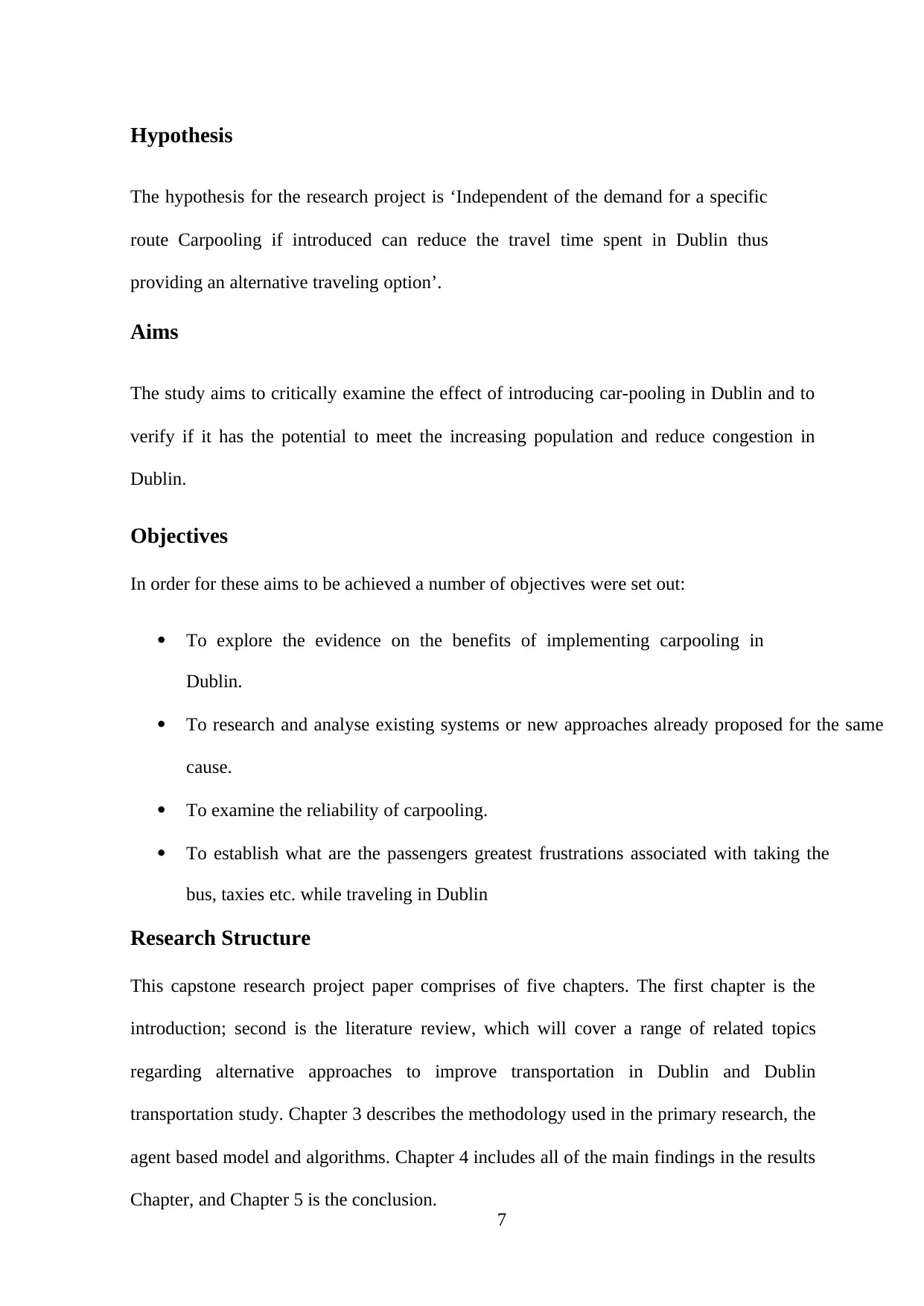
7
Hypothesis
The hypothesis for the research project is ‘Independent of the demand for a specific
route Carpooling if introduced can reduce the travel time spent in Dublin thus
providing an alternative traveling option’.
Aims
The study aims to critically examine the effect of introducing car-pooling in Dublin and to
verify if it has the potential to meet the increasing population and reduce congestion in
Dublin.
Objectives
In order for these aims to be achieved a number of objectives were set out:
To explore the evidence on the benefits of implementing carpooling in
Dublin.
To research and analyse existing systems or new approaches already proposed for the same
cause.
To examine the reliability of carpooling.
To establish what are the passengers greatest frustrations associated with taking the
bus, taxies etc. while traveling in Dublin
Research Structure
This capstone research project paper comprises of five chapters. The first chapter is the
introduction; second is the literature review, which will cover a range of related topics
regarding alternative approaches to improve transportation in Dublin and Dublin
transportation study. Chapter 3 describes the methodology used in the primary research, the
agent based model and algorithms. Chapter 4 includes all of the main findings in the results
Chapter, and Chapter 5 is the conclusion.
Hypothesis
The hypothesis for the research project is ‘Independent of the demand for a specific
route Carpooling if introduced can reduce the travel time spent in Dublin thus
providing an alternative traveling option’.
Aims
The study aims to critically examine the effect of introducing car-pooling in Dublin and to
verify if it has the potential to meet the increasing population and reduce congestion in
Dublin.
Objectives
In order for these aims to be achieved a number of objectives were set out:
To explore the evidence on the benefits of implementing carpooling in
Dublin.
To research and analyse existing systems or new approaches already proposed for the same
cause.
To examine the reliability of carpooling.
To establish what are the passengers greatest frustrations associated with taking the
bus, taxies etc. while traveling in Dublin
Research Structure
This capstone research project paper comprises of five chapters. The first chapter is the
introduction; second is the literature review, which will cover a range of related topics
regarding alternative approaches to improve transportation in Dublin and Dublin
transportation study. Chapter 3 describes the methodology used in the primary research, the
agent based model and algorithms. Chapter 4 includes all of the main findings in the results
Chapter, and Chapter 5 is the conclusion.
Paraphrase This Document
Need a fresh take? Get an instant paraphrase of this document with our AI Paraphraser
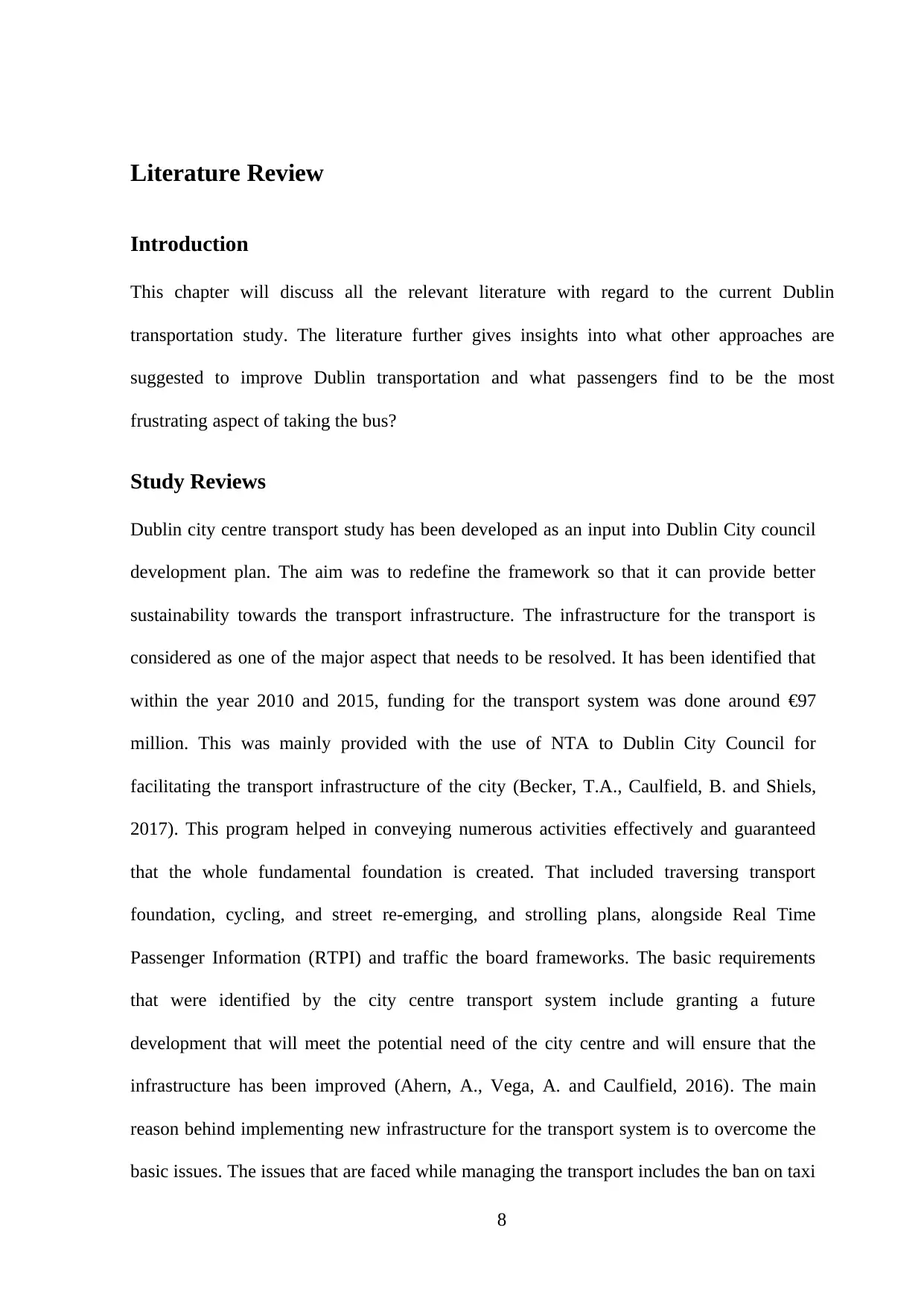
8
Literature Review
Introduction
This chapter will discuss all the relevant literature with regard to the current Dublin
transportation study. The literature further gives insights into what other approaches are
suggested to improve Dublin transportation and what passengers find to be the most
frustrating aspect of taking the bus?
Study Reviews
Dublin city centre transport study has been developed as an input into Dublin City council
development plan. The aim was to redefine the framework so that it can provide better
sustainability towards the transport infrastructure. The infrastructure for the transport is
considered as one of the major aspect that needs to be resolved. It has been identified that
within the year 2010 and 2015, funding for the transport system was done around €97
million. This was mainly provided with the use of NTA to Dublin City Council for
facilitating the transport infrastructure of the city (Becker, T.A., Caulfield, B. and Shiels,
2017). This program helped in conveying numerous activities effectively and guaranteed
that the whole fundamental foundation is created. That included traversing transport
foundation, cycling, and street re-emerging, and strolling plans, alongside Real Time
Passenger Information (RTPI) and traffic the board frameworks. The basic requirements
that were identified by the city centre transport system include granting a future
development that will meet the potential need of the city centre and will ensure that the
infrastructure has been improved (Ahern, A., Vega, A. and Caulfield, 2016). The main
reason behind implementing new infrastructure for the transport system is to overcome the
basic issues. The issues that are faced while managing the transport includes the ban on taxi
Literature Review
Introduction
This chapter will discuss all the relevant literature with regard to the current Dublin
transportation study. The literature further gives insights into what other approaches are
suggested to improve Dublin transportation and what passengers find to be the most
frustrating aspect of taking the bus?
Study Reviews
Dublin city centre transport study has been developed as an input into Dublin City council
development plan. The aim was to redefine the framework so that it can provide better
sustainability towards the transport infrastructure. The infrastructure for the transport is
considered as one of the major aspect that needs to be resolved. It has been identified that
within the year 2010 and 2015, funding for the transport system was done around €97
million. This was mainly provided with the use of NTA to Dublin City Council for
facilitating the transport infrastructure of the city (Becker, T.A., Caulfield, B. and Shiels,
2017). This program helped in conveying numerous activities effectively and guaranteed
that the whole fundamental foundation is created. That included traversing transport
foundation, cycling, and street re-emerging, and strolling plans, alongside Real Time
Passenger Information (RTPI) and traffic the board frameworks. The basic requirements
that were identified by the city centre transport system include granting a future
development that will meet the potential need of the city centre and will ensure that the
infrastructure has been improved (Ahern, A., Vega, A. and Caulfield, 2016). The main
reason behind implementing new infrastructure for the transport system is to overcome the
basic issues. The issues that are faced while managing the transport includes the ban on taxi
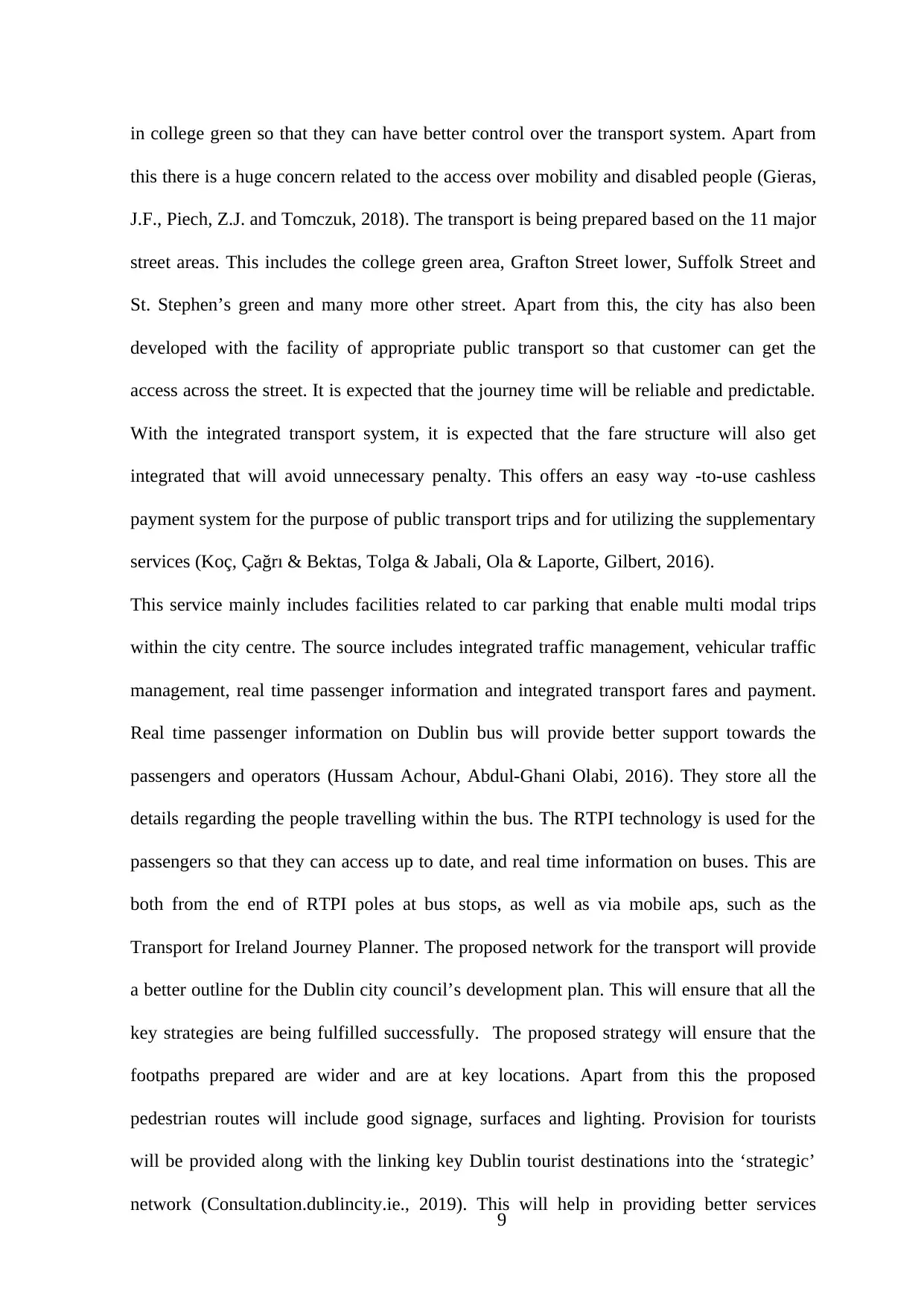
9
in college green so that they can have better control over the transport system. Apart from
this there is a huge concern related to the access over mobility and disabled people (Gieras,
J.F., Piech, Z.J. and Tomczuk, 2018). The transport is being prepared based on the 11 major
street areas. This includes the college green area, Grafton Street lower, Suffolk Street and
St. Stephen’s green and many more other street. Apart from this, the city has also been
developed with the facility of appropriate public transport so that customer can get the
access across the street. It is expected that the journey time will be reliable and predictable.
With the integrated transport system, it is expected that the fare structure will also get
integrated that will avoid unnecessary penalty. This offers an easy way -to-use cashless
payment system for the purpose of public transport trips and for utilizing the supplementary
services (Koç, Çağrı & Bektas, Tolga & Jabali, Ola & Laporte, Gilbert, 2016).
This service mainly includes facilities related to car parking that enable multi modal trips
within the city centre. The source includes integrated traffic management, vehicular traffic
management, real time passenger information and integrated transport fares and payment.
Real time passenger information on Dublin bus will provide better support towards the
passengers and operators (Hussam Achour, Abdul-Ghani Olabi, 2016). They store all the
details regarding the people travelling within the bus. The RTPI technology is used for the
passengers so that they can access up to date, and real time information on buses. This are
both from the end of RTPI poles at bus stops, as well as via mobile aps, such as the
Transport for Ireland Journey Planner. The proposed network for the transport will provide
a better outline for the Dublin city council’s development plan. This will ensure that all the
key strategies are being fulfilled successfully. The proposed strategy will ensure that the
footpaths prepared are wider and are at key locations. Apart from this the proposed
pedestrian routes will include good signage, surfaces and lighting. Provision for tourists
will be provided along with the linking key Dublin tourist destinations into the ‘strategic’
network (Consultation.dublincity.ie., 2019). This will help in providing better services
in college green so that they can have better control over the transport system. Apart from
this there is a huge concern related to the access over mobility and disabled people (Gieras,
J.F., Piech, Z.J. and Tomczuk, 2018). The transport is being prepared based on the 11 major
street areas. This includes the college green area, Grafton Street lower, Suffolk Street and
St. Stephen’s green and many more other street. Apart from this, the city has also been
developed with the facility of appropriate public transport so that customer can get the
access across the street. It is expected that the journey time will be reliable and predictable.
With the integrated transport system, it is expected that the fare structure will also get
integrated that will avoid unnecessary penalty. This offers an easy way -to-use cashless
payment system for the purpose of public transport trips and for utilizing the supplementary
services (Koç, Çağrı & Bektas, Tolga & Jabali, Ola & Laporte, Gilbert, 2016).
This service mainly includes facilities related to car parking that enable multi modal trips
within the city centre. The source includes integrated traffic management, vehicular traffic
management, real time passenger information and integrated transport fares and payment.
Real time passenger information on Dublin bus will provide better support towards the
passengers and operators (Hussam Achour, Abdul-Ghani Olabi, 2016). They store all the
details regarding the people travelling within the bus. The RTPI technology is used for the
passengers so that they can access up to date, and real time information on buses. This are
both from the end of RTPI poles at bus stops, as well as via mobile aps, such as the
Transport for Ireland Journey Planner. The proposed network for the transport will provide
a better outline for the Dublin city council’s development plan. This will ensure that all the
key strategies are being fulfilled successfully. The proposed strategy will ensure that the
footpaths prepared are wider and are at key locations. Apart from this the proposed
pedestrian routes will include good signage, surfaces and lighting. Provision for tourists
will be provided along with the linking key Dublin tourist destinations into the ‘strategic’
network (Consultation.dublincity.ie., 2019). This will help in providing better services
⊘ This is a preview!⊘
Do you want full access?
Subscribe today to unlock all pages.

Trusted by 1+ million students worldwide
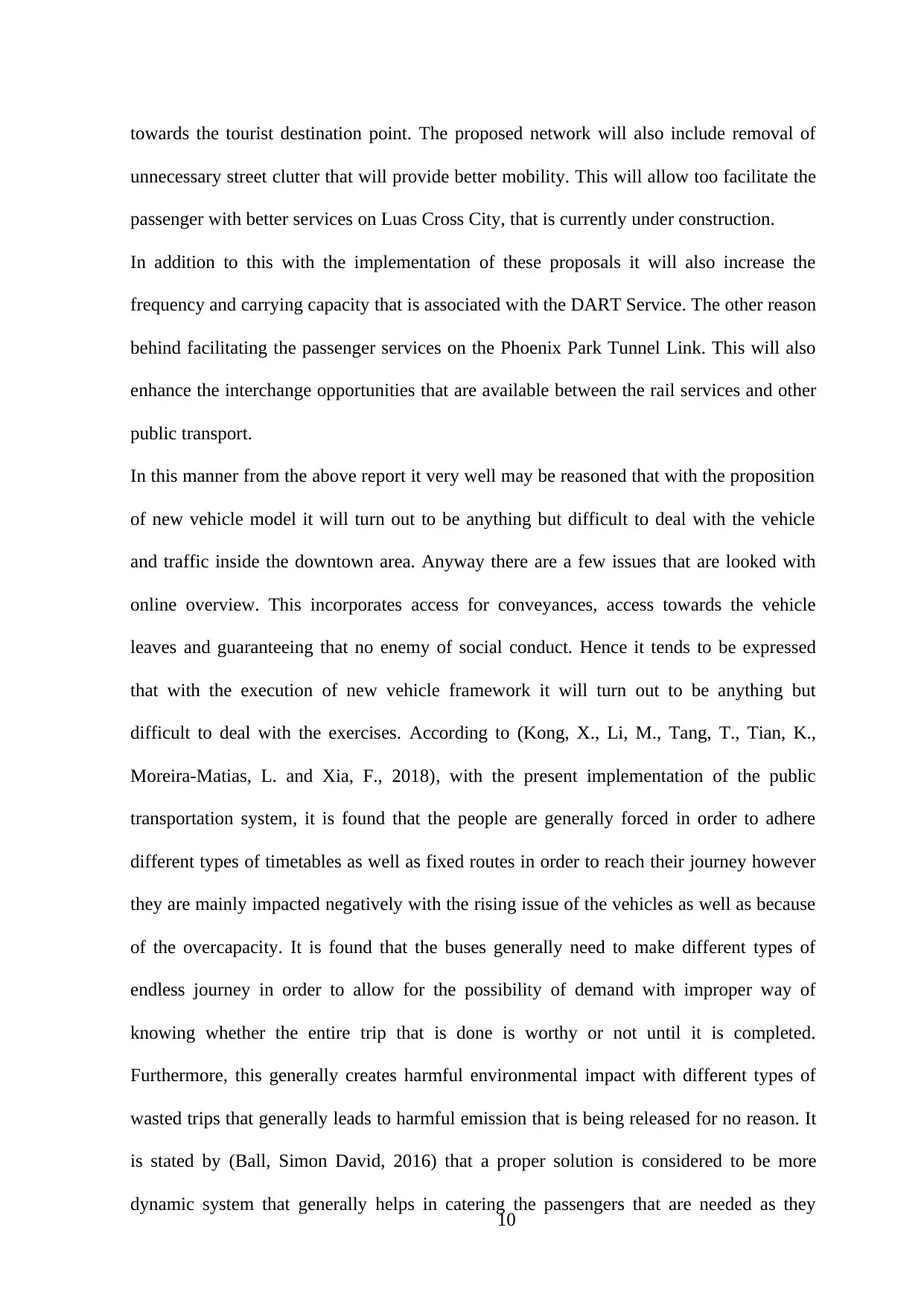
10
towards the tourist destination point. The proposed network will also include removal of
unnecessary street clutter that will provide better mobility. This will allow too facilitate the
passenger with better services on Luas Cross City, that is currently under construction.
In addition to this with the implementation of these proposals it will also increase the
frequency and carrying capacity that is associated with the DART Service. The other reason
behind facilitating the passenger services on the Phoenix Park Tunnel Link. This will also
enhance the interchange opportunities that are available between the rail services and other
public transport.
In this manner from the above report it very well may be reasoned that with the proposition
of new vehicle model it will turn out to be anything but difficult to deal with the vehicle
and traffic inside the downtown area. Anyway there are a few issues that are looked with
online overview. This incorporates access for conveyances, access towards the vehicle
leaves and guaranteeing that no enemy of social conduct. Hence it tends to be expressed
that with the execution of new vehicle framework it will turn out to be anything but
difficult to deal with the exercises. According to (Kong, X., Li, M., Tang, T., Tian, K.,
Moreira-Matias, L. and Xia, F., 2018), with the present implementation of the public
transportation system, it is found that the people are generally forced in order to adhere
different types of timetables as well as fixed routes in order to reach their journey however
they are mainly impacted negatively with the rising issue of the vehicles as well as because
of the overcapacity. It is found that the buses generally need to make different types of
endless journey in order to allow for the possibility of demand with improper way of
knowing whether the entire trip that is done is worthy or not until it is completed.
Furthermore, this generally creates harmful environmental impact with different types of
wasted trips that generally leads to harmful emission that is being released for no reason. It
is stated by (Ball, Simon David, 2016) that a proper solution is considered to be more
dynamic system that generally helps in catering the passengers that are needed as they
towards the tourist destination point. The proposed network will also include removal of
unnecessary street clutter that will provide better mobility. This will allow too facilitate the
passenger with better services on Luas Cross City, that is currently under construction.
In addition to this with the implementation of these proposals it will also increase the
frequency and carrying capacity that is associated with the DART Service. The other reason
behind facilitating the passenger services on the Phoenix Park Tunnel Link. This will also
enhance the interchange opportunities that are available between the rail services and other
public transport.
In this manner from the above report it very well may be reasoned that with the proposition
of new vehicle model it will turn out to be anything but difficult to deal with the vehicle
and traffic inside the downtown area. Anyway there are a few issues that are looked with
online overview. This incorporates access for conveyances, access towards the vehicle
leaves and guaranteeing that no enemy of social conduct. Hence it tends to be expressed
that with the execution of new vehicle framework it will turn out to be anything but
difficult to deal with the exercises. According to (Kong, X., Li, M., Tang, T., Tian, K.,
Moreira-Matias, L. and Xia, F., 2018), with the present implementation of the public
transportation system, it is found that the people are generally forced in order to adhere
different types of timetables as well as fixed routes in order to reach their journey however
they are mainly impacted negatively with the rising issue of the vehicles as well as because
of the overcapacity. It is found that the buses generally need to make different types of
endless journey in order to allow for the possibility of demand with improper way of
knowing whether the entire trip that is done is worthy or not until it is completed.
Furthermore, this generally creates harmful environmental impact with different types of
wasted trips that generally leads to harmful emission that is being released for no reason. It
is stated by (Ball, Simon David, 2016) that a proper solution is considered to be more
dynamic system that generally helps in catering the passengers that are needed as they
Paraphrase This Document
Need a fresh take? Get an instant paraphrase of this document with our AI Paraphraser
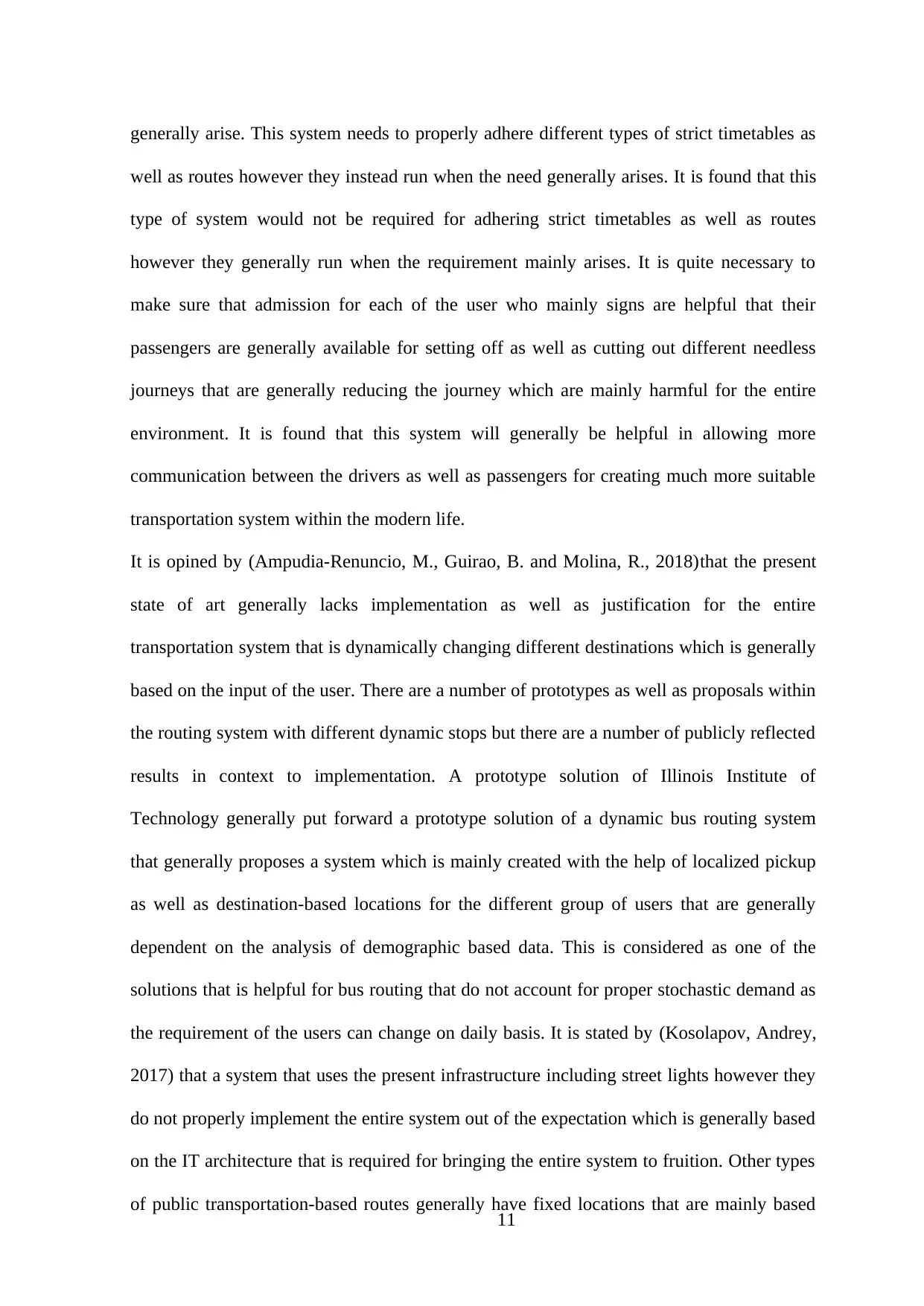
11
generally arise. This system needs to properly adhere different types of strict timetables as
well as routes however they instead run when the need generally arises. It is found that this
type of system would not be required for adhering strict timetables as well as routes
however they generally run when the requirement mainly arises. It is quite necessary to
make sure that admission for each of the user who mainly signs are helpful that their
passengers are generally available for setting off as well as cutting out different needless
journeys that are generally reducing the journey which are mainly harmful for the entire
environment. It is found that this system will generally be helpful in allowing more
communication between the drivers as well as passengers for creating much more suitable
transportation system within the modern life.
It is opined by (Ampudia-Renuncio, M., Guirao, B. and Molina, R., 2018)that the present
state of art generally lacks implementation as well as justification for the entire
transportation system that is dynamically changing different destinations which is generally
based on the input of the user. There are a number of prototypes as well as proposals within
the routing system with different dynamic stops but there are a number of publicly reflected
results in context to implementation. A prototype solution of Illinois Institute of
Technology generally put forward a prototype solution of a dynamic bus routing system
that generally proposes a system which is mainly created with the help of localized pickup
as well as destination-based locations for the different group of users that are generally
dependent on the analysis of demographic based data. This is considered as one of the
solutions that is helpful for bus routing that do not account for proper stochastic demand as
the requirement of the users can change on daily basis. It is stated by (Kosolapov, Andrey,
2017) that a system that uses the present infrastructure including street lights however they
do not properly implement the entire system out of the expectation which is generally based
on the IT architecture that is required for bringing the entire system to fruition. Other types
of public transportation-based routes generally have fixed locations that are mainly based
generally arise. This system needs to properly adhere different types of strict timetables as
well as routes however they instead run when the need generally arises. It is found that this
type of system would not be required for adhering strict timetables as well as routes
however they generally run when the requirement mainly arises. It is quite necessary to
make sure that admission for each of the user who mainly signs are helpful that their
passengers are generally available for setting off as well as cutting out different needless
journeys that are generally reducing the journey which are mainly harmful for the entire
environment. It is found that this system will generally be helpful in allowing more
communication between the drivers as well as passengers for creating much more suitable
transportation system within the modern life.
It is opined by (Ampudia-Renuncio, M., Guirao, B. and Molina, R., 2018)that the present
state of art generally lacks implementation as well as justification for the entire
transportation system that is dynamically changing different destinations which is generally
based on the input of the user. There are a number of prototypes as well as proposals within
the routing system with different dynamic stops but there are a number of publicly reflected
results in context to implementation. A prototype solution of Illinois Institute of
Technology generally put forward a prototype solution of a dynamic bus routing system
that generally proposes a system which is mainly created with the help of localized pickup
as well as destination-based locations for the different group of users that are generally
dependent on the analysis of demographic based data. This is considered as one of the
solutions that is helpful for bus routing that do not account for proper stochastic demand as
the requirement of the users can change on daily basis. It is stated by (Kosolapov, Andrey,
2017) that a system that uses the present infrastructure including street lights however they
do not properly implement the entire system out of the expectation which is generally based
on the IT architecture that is required for bringing the entire system to fruition. Other types
of public transportation-based routes generally have fixed locations that are mainly based
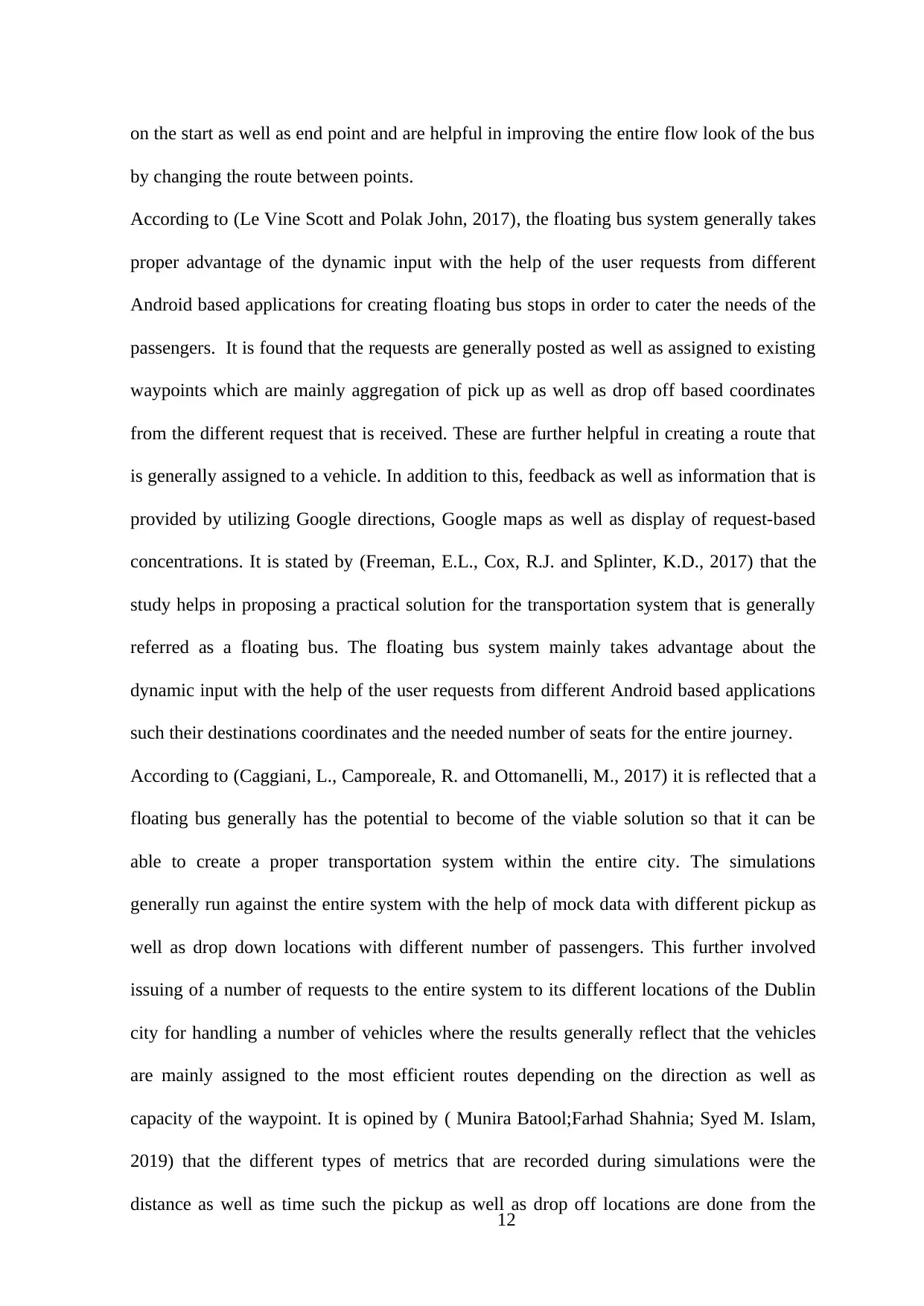
12
on the start as well as end point and are helpful in improving the entire flow look of the bus
by changing the route between points.
According to (Le Vine Scott and Polak John, 2017), the floating bus system generally takes
proper advantage of the dynamic input with the help of the user requests from different
Android based applications for creating floating bus stops in order to cater the needs of the
passengers. It is found that the requests are generally posted as well as assigned to existing
waypoints which are mainly aggregation of pick up as well as drop off based coordinates
from the different request that is received. These are further helpful in creating a route that
is generally assigned to a vehicle. In addition to this, feedback as well as information that is
provided by utilizing Google directions, Google maps as well as display of request-based
concentrations. It is stated by (Freeman, E.L., Cox, R.J. and Splinter, K.D., 2017) that the
study helps in proposing a practical solution for the transportation system that is generally
referred as a floating bus. The floating bus system mainly takes advantage about the
dynamic input with the help of the user requests from different Android based applications
such their destinations coordinates and the needed number of seats for the entire journey.
According to (Caggiani, L., Camporeale, R. and Ottomanelli, M., 2017) it is reflected that a
floating bus generally has the potential to become of the viable solution so that it can be
able to create a proper transportation system within the entire city. The simulations
generally run against the entire system with the help of mock data with different pickup as
well as drop down locations with different number of passengers. This further involved
issuing of a number of requests to the entire system to its different locations of the Dublin
city for handling a number of vehicles where the results generally reflect that the vehicles
are mainly assigned to the most efficient routes depending on the direction as well as
capacity of the waypoint. It is opined by ( Munira Batool;Farhad Shahnia; Syed M. Islam,
2019) that the different types of metrics that are recorded during simulations were the
distance as well as time such the pickup as well as drop off locations are done from the
on the start as well as end point and are helpful in improving the entire flow look of the bus
by changing the route between points.
According to (Le Vine Scott and Polak John, 2017), the floating bus system generally takes
proper advantage of the dynamic input with the help of the user requests from different
Android based applications for creating floating bus stops in order to cater the needs of the
passengers. It is found that the requests are generally posted as well as assigned to existing
waypoints which are mainly aggregation of pick up as well as drop off based coordinates
from the different request that is received. These are further helpful in creating a route that
is generally assigned to a vehicle. In addition to this, feedback as well as information that is
provided by utilizing Google directions, Google maps as well as display of request-based
concentrations. It is stated by (Freeman, E.L., Cox, R.J. and Splinter, K.D., 2017) that the
study helps in proposing a practical solution for the transportation system that is generally
referred as a floating bus. The floating bus system mainly takes advantage about the
dynamic input with the help of the user requests from different Android based applications
such their destinations coordinates and the needed number of seats for the entire journey.
According to (Caggiani, L., Camporeale, R. and Ottomanelli, M., 2017) it is reflected that a
floating bus generally has the potential to become of the viable solution so that it can be
able to create a proper transportation system within the entire city. The simulations
generally run against the entire system with the help of mock data with different pickup as
well as drop down locations with different number of passengers. This further involved
issuing of a number of requests to the entire system to its different locations of the Dublin
city for handling a number of vehicles where the results generally reflect that the vehicles
are mainly assigned to the most efficient routes depending on the direction as well as
capacity of the waypoint. It is opined by ( Munira Batool;Farhad Shahnia; Syed M. Islam,
2019) that the different types of metrics that are recorded during simulations were the
distance as well as time such the pickup as well as drop off locations are done from the
⊘ This is a preview!⊘
Do you want full access?
Subscribe today to unlock all pages.

Trusted by 1+ million students worldwide
1 out of 30
Related Documents
Your All-in-One AI-Powered Toolkit for Academic Success.
+13062052269
info@desklib.com
Available 24*7 on WhatsApp / Email
![[object Object]](/_next/static/media/star-bottom.7253800d.svg)
Unlock your academic potential
Copyright © 2020–2025 A2Z Services. All Rights Reserved. Developed and managed by ZUCOL.





